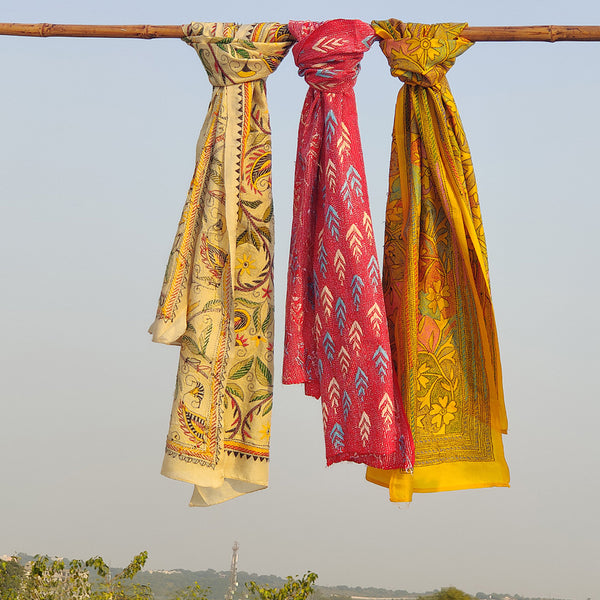India is a melting pot of different cultures and each state has its own exquisite charm and unique place in the cultural fibre of India. One such state that has managed to amaze and inspire people for its amazing artistic lineage, cultural heritage, vibrant traditions and skilled artisans, is Gujarat. The long-standing history of the intricate crafts of Gujarat reflects the creativity and craftsmanship of its people. Gujarat handicrafts are an essential aspect of daily life for Gujaratis. Keep reading this blog to explore five incredible art and craft of Gujarat.
5 Gujarati Art Form You Must Own
Let’s delve into the famous handicrafts of Gujarat reflecting the diversity of the state.
Ajrak Block Prints
Ajrakh is a well-known traditional vegetable dye that may be used to dye fabrics. Ajrakh is typically printed in two orientations namely ekpuri which is single-sided and bipuri which is double-sided. Moreover, the traditional 'Ajrakh' involves several dyeing steps and resist printing using natural dyes. Ajrak Block Prints is one of the Gujarati handicrafts that originated in Kutch and is practised by the Sikh and Kutchi communities. Hardwoods, pomegranate seeds & bark, and wild indigo are a few of the often used ingredients in it. Starch is taken out of the dough using camel dung which is plentiful in this area. Ajrakh was printed on both sides in the past because there was no electricity at that time. The herders who usually wore Ajrakh left their houses before sunrise and were unable to tell which side was right in the dark. Ajrakh was printed on both sides for this reason.
Copper Bells
The art of making copper bells is now happening in only two villages of Bhuj, Gujarat. This Gujarat art form of copper bells has a unique and melodious sound thanks to a wooden piece attached to the bell's centre. To obtain the appropriate pitch, the bells are beaten with a hammer. Indians have been aware of this metal craft for around 5,000 years. However, historical evidence demonstrates that this kind of metal craft dates back to the Indus Valley civilization. This is demonstrated by the exquisite figurine of "The Dancer" by Mohanjodaro. Copper is used to make different alloys like bronze, brass, and bell by fusing it with other metals (mostly tin and zinc). One of the most significant handicrafts of Kuchch is the art of creating bell metal crafts.

Kutchi Embroidery
Using silk or woollen thread and fine stitches, kutch work embroidery involves intricate and detailed patterns. The mirrors, shells, and beads further beautify this traditional art of Gujarat. Kutchi embroidery generally uses green, black, yellow, ivory, crimson, and indigo colours. Beautiful motifs and designs featuring human figures in dancing positions, along with dancing peacocks, are the main sources of inspiration for Kutch embroidery. The beauty of the designs is further emboldened by the use of small mirrors which are believed to personify water and ward off evil. The origins of Kutch embroidery can be found in the migration of immigrants to Gujarat in the 16th and 17th centuries from places including Greece, Germany, Iran, and Iraq. It is also claimed that the Muslim Sufi saints of Sindh trained the cobblers in this craft.

Patch Work
The art of patch work involves sewing together small, shaped pieces of fabric with a variety of patterns, colours, and textures to form bigger geometric shapes. Originally employed to make patchwork quilts, this type of sewing is being widely used in apparel and home décor. It reflects Gujarat art and culture. India's tryst with appliqué and patchwork dates back to the time when Native women in Gujarat sewed hangings and made bigger canopies and tents for bullock carts. Gujarati appliqué mostly focuses on patchwork in which various fabric patterns and colours are cut into various shapes and sizes and then pieced together to create composite artworks. Patchwork colour schemes might be light, neutral or chilly.
Rogan Art
A traditional folk art form called Rogan art or cloth printing, is exclusively practised in Gujarat’s Kutch district. Until recently, Rogan's artwork was in danger of disappearing into oblivion but post the 2001 Gujarat earthquake many cooperatives and NGOs got together to revive this art form to generate employment for the artisans. The process used to create the Rogan cloth portrayal is exhaustive and hard. First, castor seed oil is periodically heated for twelve to fourteen hours in a cauldron. The entire process takes a few days. After coming into contact with cold water, the heated castor oil hardens and transforms into the slimy, golden-brown substance known as Rogan.
Interestingly, When Indian Prime Minister Narender Modi visited the White House in 2014, he gifted two Rogan art paintings to President Obama.

Final Words
These crafts of Gujarat not only showcase the artistic prowess of the people of Gujarat but also contribute significantly to the cultural identity and economic prosperity of the region. iTokri maintains the legacy of Gujarati handicrafts and wants to exhibit the same to a far-reaching audience. You can visit the website to explore different kinds of indigenous handicrafts and art forms.



























Leave a comment (all fields required)